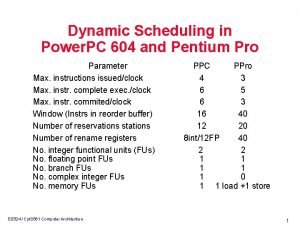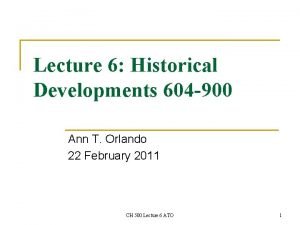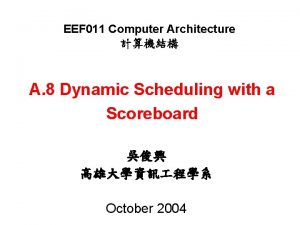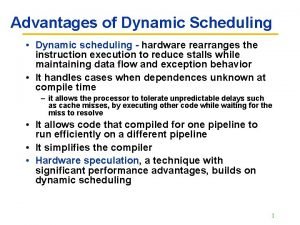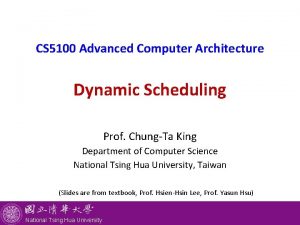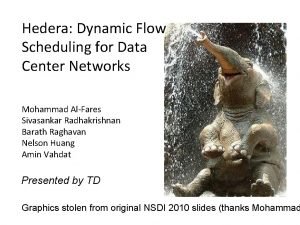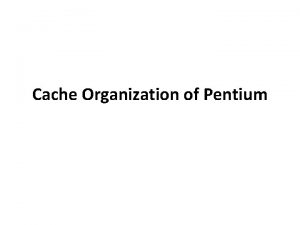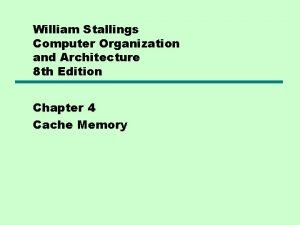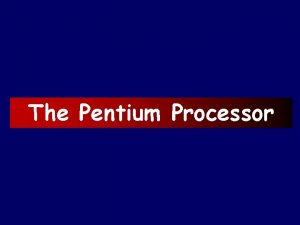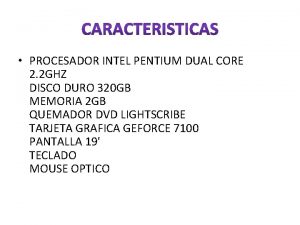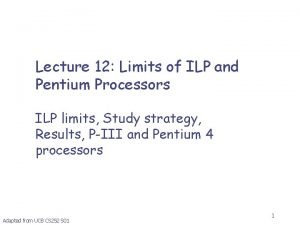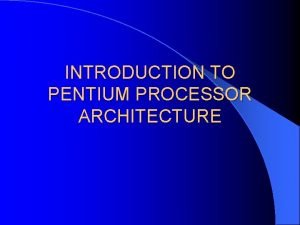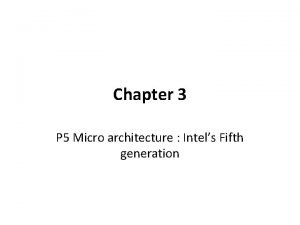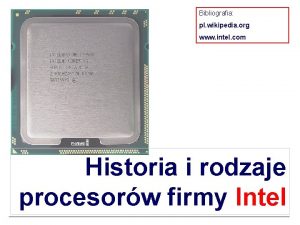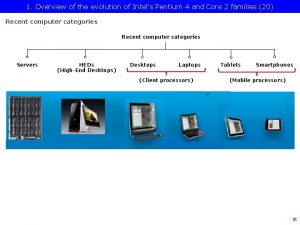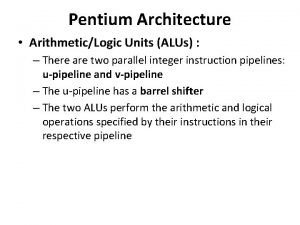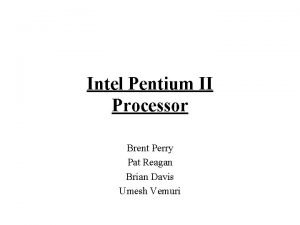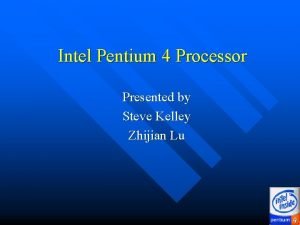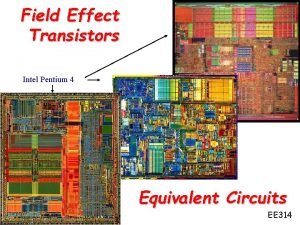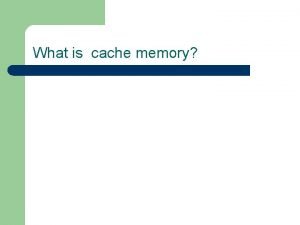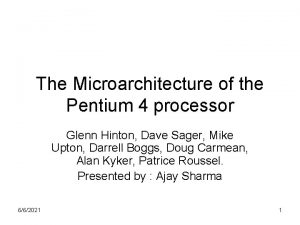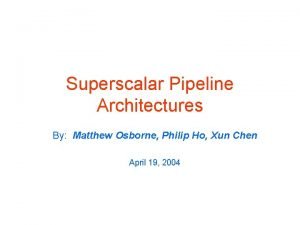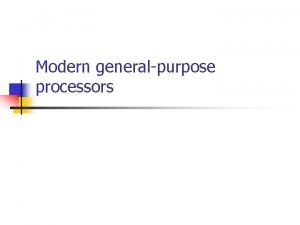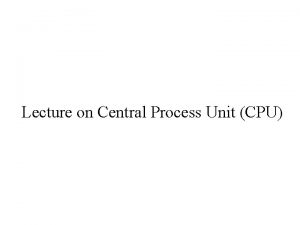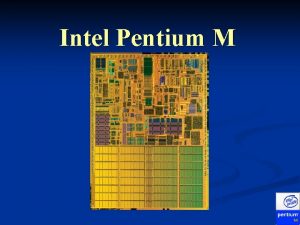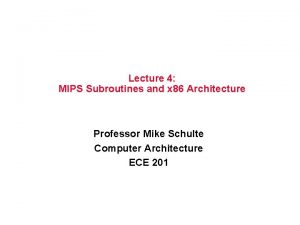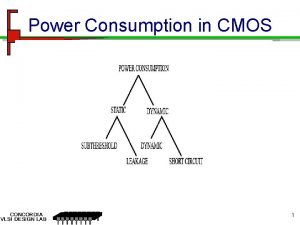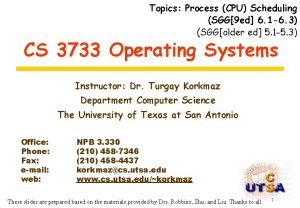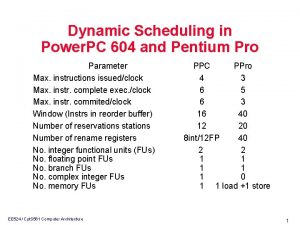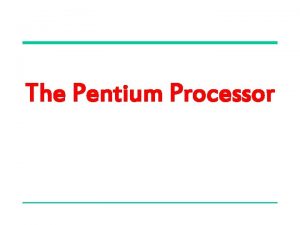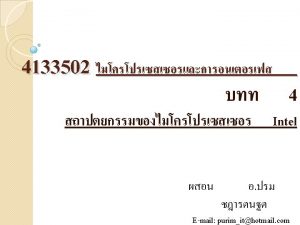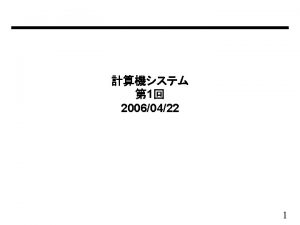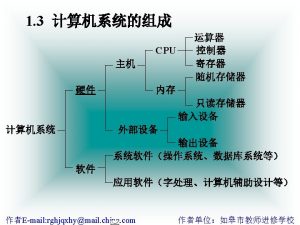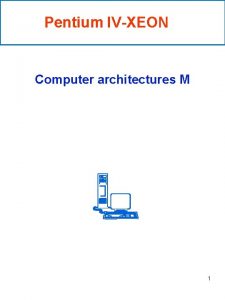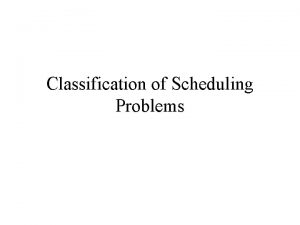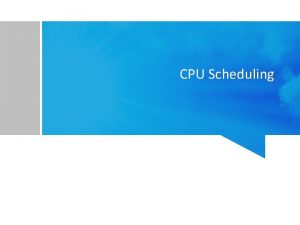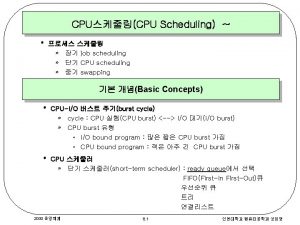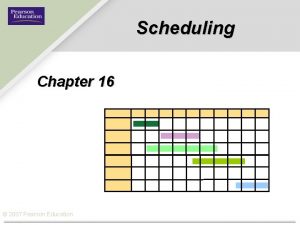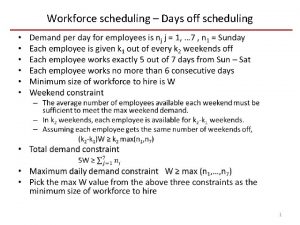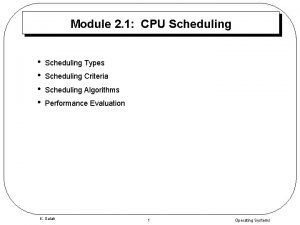Dynamic Scheduling in Power PC 604 and Pentium
















































- Slides: 48

Dynamic Scheduling in Power. PC 604 and Pentium Pro Parameter Max. instructions issued/clock Max. instr. complete exec. /clock Max. instr. commited/clock Window (Instrs in reorder buffer) Number of reservations stations Number of rename registers No. integer functional units (FUs) No. floating point FUs No. branch FUs No. complex integer FUs No. memory FUs EE 524 / Cpt. S 561 Computer Architecture PPC PPro 4 3 6 5 6 3 16 40 12 20 8 int/12 FP 40 2 2 1 1 1 0 1 1 load +1 store 1

Dynamic Scheduling in Pentium Pro • PPro doesn’t pipeline 80 x 86 instructions • PPro decode unit translates the Intel instructions into 72 bit micro operations ( DLX MIPS) • Sends micro operations to reorder buffer & reservation stations • Takes 1 clock cycle to determine length of 80 x 86 instructions + 2 more to create the micro operations • 12 14 clocks in total pipeline ( 3 state machines) • Many instructions translate to 1 to 4 micro operations • Complex 80 x 86 instructions are executed by a conventional microprogram (8 K x 72 bits) that issues long sequences of micro operations EE 524 / Cpt. S 561 Computer Architecture 2

Getting CPI < 1: Issuing Multiple Instructions/Cycle • Two variations – Superscalar: varying no. instructions/cycle (1 to 8), scheduled by compiler or by HW (Tomasulo) » IBM Power. PC, Sun Ultra. Sparc, DEC Alpha, HP 8000 – (Very) Long Instruction Words (V)LIW: fixed number of instructions (4 16) scheduled by the compiler; put ops into wide templates » Joint HP/Intel agreement in 1999/2000 » Intel Architecture 64 (IA 64) 64 bit address » Style: “Explicitly Parallel Instruction Computer (EPIC)” • Anticipated success lead to use of Instructions Per Clock cycle (IPC) vs. CPI EE 524 / Cpt. S 561 Computer Architecture 3

Getting CPI < 1: Issuing Multiple Instructions/Cycle • Superscalar DLX: 2 instructions, 1 FP & 1 anything else – Fetch 64 bits/clock cycle; Int on left, FP on right – Can only issue 2 nd instruction if 1 st instruction issues – More ports for FP registers to do FP load & FP op in a pair Type Pipe Stages Int. instruction IF ID EX MEM WB FP instruction IF ID EX MEM WB • 1 cycle load delay expands to 3 instructions in SS – instruction in right half can’t use it, nor instructions in next slot EE 524 / Cpt. S 561 Computer Architecture 4

Superscalar IF ID EX M WB IF ID EX M WB IF ID EX M WB EE 524 / Cpt. S 561 Computer Architecture 5

Review: Unrolled Loop that Minimizes Stalls for Scalar 1 Loop: 2 3 4 5 6 7 8 9 10 11 12 13 14 LD LD ADDD SD SD SD SUBI BNEZ SD F 0, 0(R 1) F 6, -8(R 1) F 10, -16(R 1) F 14, -24(R 1) F 4, F 0, F 2 F 8, F 6, F 2 F 12, F 10, F 2 F 16, F 14, F 2 0(R 1), F 4 -8(R 1), F 8 -16(R 1), F 12 R 1, #32 R 1, LOOP 8(R 1), F 16 LD to ADDD: 1 Cycle ADDD to SD: 2 Cycles ; 8 -32 = -24 14 clock cycles, or 3. 5 per iteration EE 524 / Cpt. S 561 Computer Architecture 6

Loop Unrolling in Superscalar Integer instruction Loop: LD F 0, 0(R 1) LD F 6, 8(R 1) LD F 10, 16(R 1) LD F 14, 24(R 1) LD F 18, 32(R 1) SD 0(R 1), F 4 SD 8(R 1), F 8 SD 16(R 1), F 12 SD 24(R 1), F 16 SUBI R 1, #40 BNEZ R 1, LOOP SD 32(R 1), F 20 FP instruction Clock cycle ADDD F 4, F 0, F 2 ADDD F 8, F 6, F 2 ADDD F 12, F 10, F 2 ADDD F 16, F 14, F 2 ADDD F 20, F 18, F 2 1 2 3 4 5 6 7 8 9 10 11 12 • Unrolled 5 times to avoid delays (+1 due to SS) • 12 clocks, or 2. 4 clocks per iteration (1. 5 X) EE 524 / Cpt. S 561 Computer Architecture 7

Multiple Issue Challenges • Integer/FP split is simple for HW, get CPI of 0. 5 only for programs /w: – Exactly 50% FP operations – No hazards • If more instructions issue at same time, greater difficulty of decode and issue – Even 2 scalar => examine 2 opcodes, 6 register specifiers, & decide if 1 or 2 instructions can issue • VLIW: tradeoff instruction space for simple decoding – The very long instruction word (VLIW) has room for many operations – By definition, all the operations the compiler puts in the long instruction word are independent they can be executed in parallel – E. g. , 2 integer operations, 2 FP ops, 2 Memory refs, 1 branch » 16 to 24 bits per field => 7*16 or 112 bits to 7*24 or 168 bits wide – Need compiling technique that schedules across several branches EE 524 / Cpt. S 561 Computer Architecture 8

VLIW Mem. ref. 1 Mem. ref. 2 EE 524 / Cpt. S 561 Computer Architecture FP op. 1 FP op. 2 inst branch 9

Loop Unrolling in VLIW Memory reference 1 Memory reference 2 FP operation 1 FP op. 2 Int. op/ branch Clock LD F 0, 0(R 1) LD F 6, -8(R 1) LD F 10, -16(R 1) LD F 14, -24(R 1) LD F 18, -32(R 1) LD F 22, -40(R 1) ADDD F 4, F 0, F 2 ADDD F 8, F 6, F 2 LD F 26, -48(R 1) ADDD F 12, F 10, F 2 ADDD F 16, F 14, F 2 ADDD F 20, F 18, F 2 ADDD F 24, F 22, F 2 SD 0(R 1), F 4 SD -8(R 1), F 8 ADDD F 28, F 26, F 2 SD -16(R 1), F 12 SD -24(R 1), F 16 SD -32(R 1), F 20 SD -40(R 1), F 24 SUBI R 1, #48 SD -0(R 1), F 28 BNEZ R 1, LOOP 1 2 3 4 5 6 7 8 9 Unrolled 7 times to avoid delays 7 results in 9 clocks, or 1. 3 clocks per iteration (1. 8 X) Average: 2. 5 ops per clock, 50% efficiency Note: Need more registers in VLIW (15 vs. 6 in SS) EE 524 / Cpt. S 561 Computer Architecture 10

Trace Scheduling • Parallelism across IF branches vs. LOOP branches • Two steps: – Trace Selection » Find likely sequence of basic blocks (trace) of (statically predicted or profile predicted) long sequence of straight line code – Trace Compaction » Squeeze trace into few VLIW instructions » Need bookkeeping code in case prediction is wrong • Compiler undoes bad guess (discards values in registers) • Subtle compiler bugs mean wrong answer vs. poor performance; no hardware interlocks EE 524 / Cpt. S 561 Computer Architecture 11

Advantages of HW (Tomasulo) vs. SW (VLIW) Speculation • • • HW determines address conflicts HW better branch prediction HW maintains precise exception model HW does not execute bookkeeping instructions Works across multiple implementations SW speculation is much easier for HW design EE 524 / Cpt. S 561 Computer Architecture 12

Superscalar vs. VLIW • Smaller code size • Binary compatability across generations of hardware EE 524 / Cpt. S 561 Computer Architecture • Simplified Hardware for decoding, issuing instructions • No Interlock Hardware (compiler checks? ) • More registers, but simplified Hardware for Register Ports (multiple independent register files? ) 13

Intel/HP IA-64 “Explicitly Parallel Instruction Computer (EPIC)” • IA-64: instruction set architecture • 128 64 -bit integer regs + 128 82 -bit floating point regs – Not separate register files per functional unit as in old VLIW • Hardware checks dependencies (interlocks => binary compatibility over time) • Predicated execution (select 1 out of 64 1 -bit flags) => 40% fewer mispredictions? • Itanium™ was first implementation (2001) – Highly parallel and deeply pipelined hardware at 800 MHz – 6 -wide, 10 -stage pipeline at 800 Mhz on 0. 18 µ process • Itanium 2™ is name of 2 nd implementation (2005) – 6 -wide, 8 -stage pipeline at 1666 MHz on 0. 13 µm process – Caches: 32 KB I, 32 KB D, 128 KB L 2 I, 128 KB L 2 D, 9216 KB L 3 EE 524 / Cpt. S 561 Computer Architecture 14

Execution units EE 524 / Cpt. S 561 Computer Architecture 15

EE 524 / Cpt. S 561 Computer Architecture 16

EE 524 / Cpt. S 561 Computer Architecture 17

Bundle 9: MMI 14: MMF 15: MMF 15: MMF 17: MIB Slot 0 LD F 0, 0(R 1) LD F 10, -16(R 1) LD F 18, -32(R 1) LD F 26, -48(R 1) SD F 8, -8(R 1) SD F 16, -24(R 1) SD F 20, -32(R 1) SD F 24, -40(R 1) SD F 28, -48(R 1) EE 524 / Cpt. S 561 Computer Architecture Slot 1 LD F 6, -8(R 1) LD F 14, -24(R 1) LD F 22, -40(R 1) SD F 4, 0(R 1) SD F 12, -16(R 1) Slot 2 EX 1 ADD F 4, F 0, F 2 3 ADD F 8, F 6, F 2 4 ADD F 12, F 10, F 2 6 ADD F 16, F 14, F 2 9 ADD F 20, F 18, F 2 12 ADD F 24, F 22, F 2 15 ADD F 28, F 26, F 2 18 ADD R 1, #-56 BNE R 1, R 2, Loop 21 18

Bundle 8: MMI 9: MMI 14: MMF 15: MMF 14: MMF 9: MMI 17: MIB Slot 0 LD F 0, 0(R 1) LD F 10, -16(R 1) LD F 18, -32(R 1) LD F 26, -48(R 1) Slot 1 Slot 2 EX LD F 6, -8(R 1) 1 LD F 14, -24(R 1) 2 LD F 22, -40(R 1) ADD F 4, F 0, F 2 3 ADD F 8, F 6, F 2 4 ADD F 12, F 10, F 2 5 SD F 4, 0(R 1) ADD F 16, F 14, F 2 6 SD F 8, -8(R 1) ADD F 20, F 18, F 2 7 SD F 12, -16(R 1) ADD F 24, F 22, F 2 8 SD F 16, -24(R 1) ADD F 28, F 26, F 2 9 SD F 20, -32(R 1) SD F 24, -40(R 1) 11 SD F 28, -48(R 1) ADD R 1, #-56 BNE R 1, R 2, Loop 12 EE 524 / Cpt. S 561 Computer Architecture 19

(Mis) Speculation on Pentium 4 vzip vpr gcc mcf crafty wupsise swim mgrid applu mesa Misspeculation Fraction • % of micro-ops not used Integer EE 524 / Cpt. S 561 Computer Architecture Floating Point 20

More Instruction Fetch Bandwidth • Integrated branch prediction branch predictor is part of instruction fetch unit and is constantly predicting branches • Instruction prefetch Instruction fetch units prefetch to deliver multiple instructions per clock, integrating it with branch prediction • Instruction memory access and buffering Fetching multiple instructions per cycle: – May require accessing multiple cache blocks (prefetch to hide cost of crossing cache blocks) – Provides buffering, acting as on-demand unit to provide instructions to issue stage as needed and in quantity needed EE 524 / Cpt. S 561 Computer Architecture 21

Power 4 Single threaded predecessor to Power 5. 8 execution units in out of order engine, each may issue an instruction each cycle. IF = instruction fetch, IC = instruction cache, BP = branch predict, D 0 = decode stage 0, Xfer=transfer, GD = group dispatch, MP = mapping, ISS =instruction issue, RF EE 524 / Cpt. S 561 =register file. Computer read, Architecture EX = execute, 22

Limits to ILP RX RX Initial HW Model here; MIPS compilers. Assumptions for ideal/perfect machine to start: 1. Register renaming – infinite virtual registers => all register WAW & WAR hazards are avoided 2. Branch prediction – perfect; no mispredictions 3. Jump prediction – all jumps perfectly predicted (returns, case statements) 2 & 3 no control dependencies; perfect speculation & an unbounded buffer of instructions available 4. Memory-address alias analysis – addresses known & a load can be moved before a store provided addresses not equal; 1&4 eliminates all but RAW Also: perfect caches; 1 cycle latency for all instructions (FP *, /); unlimited instructions issued/clock cycle; EE 524 / Cpt. S 561 Computer Architecture 23

Limits to ILP HW Model comparison New Model Power 5 Instructions Issued per clock Instruction Window Size 64 (no restrictions) Infinite 4 Infinite vs. 256, 128, 64, 32 Infinite 200 Renaming Registers 64 Int + 64 FP Infinite 48 integer + 40 Fl. Pt. Branch Prediction Cache 1 K 2 -bit Perfect Tournament Perfect Memory Alias HW disambiguation Perfect 64 KI, 32 KD, 1. 92 MB L 2, 36 MB L 3 Perfect EE 524 / Cpt. S 561 Computer Architecture 24 24

Realistic HW: Window Impact (Figure 3. 7) IPC Perfect disambiguation (HW), 1 K Selective Prediction, 16 entry return, 64 registers, issue as many as window FP: 8 - 45 Integer: 6 - 12 Infinite 256 EE 524 / Cpt. S 561 Computer Architecture 128 64 32 16 825 4 25

HW v. SW to increase ILP • Memory disambiguation: HW best • Speculation: – HW best when dynamic branch prediction better than compile time (static) prediction – Exceptions easier for HW – HW doesn’t need bookkeeping code or compensation code – Very complicated to get right • Scheduling: SW can look ahead to schedule better • Compiler independence: does not require new compiler, recompilation to run better EE 524 / Cpt. S 561 Computer Architecture 26

Performance beyond single thread ILP • There can be much higher natural parallelism in some applications (e. g. , Database or Scientific codes) • Explicit Thread Level Parallelism or Data Level Parallelism • Thread: process with own instructions and data – thread may be a process part of a parallel program of multiple processes, or it may be an independent program – Each thread has all the state (instructions, data, PC, register state, and so on) necessary to allow it to execute • Data Level Parallelism: Perform identical operations on data, and lots of data EE 524 / Cpt. S 561 Computer Architecture 27

Thread Level Parallelism (TLP) Instruction Level Parallelism • • ILP exploits implicit parallel operations within a loop or straight-line code segment TLP explicitly represented by the use of multiple threads of execution that are inherently parallel Goal: Use multiple instruction streams to improve 1. Throughput of computers that run many programs 2. Execution time of multi-threaded programs TLP could be more cost-effective to exploit than ILP EE 524 / Cpt. S 561 Computer Architecture 28

New Approach: Mulithreaded Execution • Multithreading: multiple threads to share the functional units of 1 processor via overlapping – processor must duplicate independent state of each thread e. g. , a separate copy of register file, a separate PC, and for running independent programs, a separate page table – memory shared through the virtual memory mechanisms, which already support multiple processes – HW for fast thread switch; much faster than full process switch 100 s to 1000 s of clocks • When switch? – Alternate instruction per thread (fine grain) – When a thread is stalled, perhaps for a cache miss, another thread can be executed (coarse grain) EE 524 / Cpt. S 561 Computer Architecture 29

Fine-Grained Multithreading • Switches between threads on each instruction, causing the execution of multiples threads to be interleaved • Usually done in a round-robin fashion, skipping any stalled threads • CPU must be able to switch threads every clock • Advantage is it can hide both short and long stalls, since instructions from other threads executed when one thread stalls • Disadvantage is it slows down execution of individual threads, since a thready to execute without stalls will be delayed by instructions from other threads • Used on Sun’s Niagara EE 524 / Cpt. S 561 Computer Architecture 30

Course-Grained Multithreading • Switches threads only on costly stalls, such as L 2 cache misses • Advantages – Relieves need to have very fast thread-switching – Doesn’t slow down thread, since instructions from other threads issued only when the thread encounters a costly stall • Disadvantage is hard to overcome throughput losses from shorter stalls, due to pipeline start-up costs – Since CPU issues instructions from 1 thread, when a stall occurs, the pipeline must be emptied or frozen – New thread must fill pipeline before instructions can complete • Because of this start-up overhead, coarse-grained multithreading is better for reducing penalty of high cost stalls, where pipeline refill << stall time • Used in IBM AS/400 EE 524 / Cpt. S 561 Computer Architecture 31

For most apps, most execution units lie idle For an 8 way superscalar. From: Tullsen, Eggers, and Levy, “Simultaneous Multithreading: Maximizing On chip Parallelism, ISCA 1995. EE 524 / Cpt. S 561 Computer Architecture 32

Do both ILP and TLP? • TLP and ILP exploit two different kinds of parallel structure in a program • Could a processor oriented at ILP to exploit TLP? – functional units are often idle in data path designed for ILP because of either stalls or dependences in the code • Could the TLP be used as a source of independent instructions that might keep the processor busy during stalls? • Could TLP be used to employ the functional units that would otherwise lie idle when insufficient ILP exists? EE 524 / Cpt. S 561 Computer Architecture 33

Simultaneous Multi-threading. . . One thread, 8 units Cycle M M FX FX FP FP BR CC Two threads, 8 units Cycle M M FX FX FP FP BR CC 1 1 2 2 3 3 4 4 5 5 6 6 7 7 8 8 9 9 M = Load/Store, FX = Fixed Point, FP = Floating Point, BR = Branch, CC = Condition Codes EE 524 / Cpt. S 561 Computer Architecture 34

Simultaneous Multithreading (SMT) • Simultaneous multithreading (SMT): insight that dynamically scheduled processor already has many HW mechanisms to support multithreading – Large set of virtual registers that can be used to hold the register sets of independent threads – Register renaming provides unique register identifiers, so instructions from multiple threads can be mixed in datapath without confusing sources and destinations across threads – Out of order completion allows the threads to execute out of order, and get better utilization of the HW • Just adding a per thread renaming table and keeping separate PCs – Independent commitment can be supported by logically keeping a separate reorder buffer for each thread Source: Micrprocessor Report, December 6, 1999 “Compaq Chooses SMT for Alpha” EE 524 / Cpt. S 561 Computer Architecture 35

Time (processor cycle) Multithreaded Categories Superscalar Simultaneous Fine Grained. Coarse Grained Multiprocessing Multithreading Thread 1 Thread 2 EE 524 / Cpt. S 561 Computer Architecture Thread 3 Thread 4 Thread 5 Idle slot 36

Design Challenges in SMT • Since SMT makes sense only with fine-grained implementation, impact of fine-grained scheduling on single thread performance? – A preferred thread approach sacrifices neither throughput nor single thread performance? – Unfortunately, with a preferred thread, the processor is likely to sacrifice some throughput, when preferred thread stalls • Larger register file needed to hold multiple contexts • Not affecting clock cycle time is a challenge, especially in – Instruction issue more candidate instructions need to be considered – Instruction completion choosing which instructions to commit may be challenging • Ensuring that cache and TLB conflicts generated by SMT do not degrade performance EE 524 / Cpt. S 561 Computer Architecture Table Lookaside Buffer 37

Power 4 Single threaded predecessor to Power 5. 8 execution units in out of order engine, each may issue an instruction each cycle. IF = instruction fetch, IC = instruction cache, BP = branch predict, D 0 = decode stage 0, Xfer=transfer, GD = group dispatch, MP = mapping, ISS =instruction issue, RF EE 524 / Cpt. S 561 =register file. Computer read, Architecture EX = execute, 38

Power 4 IF = instruction fetch, IC = instruction cache, BP = branch predict, D 0 = decode stage 0, Xfer = transfer, GD = group dispatch, MP = mapping, ISS = instruction issue, RF = register file read, EX = execute, EA = compute address, DC = data caches, F 6 = six cycle floating point execution pipe, Fmt = data format, WB = write back, and CP = group commit Power 5 2 commits (architected register sets) 2 fetch (PC), 2 initial decodes EE 524 / Cpt. S 561 Computer Architecture 39

Power 5 data flow. . . TLBI TLBD Why only 2 threads? With 4, one of the shared resources (physical registers, cache, memory bandwidth) would be prone to bottleneck EE 524 / Cpt. S 561 Computer Architecture 40

Power 5 thread performance. . . Relative priority of each thread controllable in hardware. For balanced operation, both threads run slower than if they “owned” the machine. EE 524 / Cpt. S 561 Computer Architecture 41

Changes in Power 5 to support SMT • Increased associativity of L 1 instruction cache and the instruction address translation buffers • Added per thread load and store queues • Increased size of the L 2 (1. 92 vs. 1. 44 MB) and L 3 caches • Added separate instruction prefetch and buffering per thread • Increased the number of virtual registers from 152 to 240 • Increased the size of several issue queues • The Power 5 core is about 24% larger than the Power 4 core because of the addition of SMT support EE 524 / Cpt. S 561 Computer Architecture 42

Initial Performance of SMT • Pentium 4 Extreme SMT yields 1. 01 speedup for SPECint_rate benchmark and 1. 07 for SPECfp_rate – Pentium 4 is dual threaded SMT – SPECRate requires that each SPEC benchmark be run against a vendor-selected number of copies of the same benchmark • Running on Pentium 4 each of 26 SPEC benchmarks paired with every other (262 runs) speed-ups from 0. 90 to 1. 58; average was 1. 20 • Power 5, 8 processor server 1. 23 faster for SPECint_rate with SMT, 1. 16 faster for SPECfp_rate • Power 5 running 2 copies of each app speedup between 0. 89 and 1. 41 – Most gained some – Fl. Pt. apps had most cache conflicts and least gains EE 524 / Cpt. S 561 Computer Architecture 43

Head to Head ILP competition Processor Micro architecture Intel Pentium 4 Extreme Speculative dynamically scheduled; deeply pipelined; SMT AMD Speculative Athlon 64 dynamically FX-57 scheduled IBM Speculative Power 5 dynamically (1 CPU scheduled; SMT; only) 2 CPU cores/chip Intel Statically scheduled Itanium 2 VLIW-style EE 524 / Cpt. S 561 Computer Architecture Fetch / Issue / Execute FU Clock Rate (GHz) Transis -tors Die size Power 3/3/4 7 int. 1 FP 3. 8 125 M 122 mm 2 115 W 3/3/4 6 int. 3 FP 2. 8 8/4/8 6 int. 2 FP 1. 9 6/5/11 9 int. 2 FP 1. 6 114 M 104 115 W mm 2 200 M 80 W 300 (est. ) mm 2 (est. ) 592 M 130 423 W mm 2 44

Normalized Performance: Efficiency Rank Int/Trans FP/Trans Int/area FP/area Int/Watt FP/Watt EE 524 / Cpt. S 561 Computer Architecture I P t e a n n t i I u u m m 2 4 A t h l o n P o w e r 5 4 4 4 2 1 1 1 3 3 3 2 1 2 2 3 4 45

No Silver Bullet for ILP • No obvious over all leader in performance • The AMD Athlon leads on SPECInt performance followed by the Pentium 4, Itanium 2, and Power 5 • Itanium 2 and Power 5, which perform similarly on SPECFP, clearly dominate the Athlon and Pentium 4 on SPECFP • Itanium 2 is the most inefficient processor both for Fl. Pt. and integer code for all but one efficiency measure (SPECFP/Watt) • Athlon and Pentium 4 both make good use of transistors and area in terms of efficiency, • IBM Power 5 is the most effective user of energy on SPECFP and essentially tied on SPECINT EE 524 / Cpt. S 561 Computer Architecture 46

Limits to ILP • Doubling issue rates above today’s 3 -6 instructions per clock, say to 6 to 12 instructions, probably requires a processor to – – issue 3 or 4 data memory accesses per cycle, resolve 2 or 3 branches per cycle, rename and access more than 20 registers per cycle, and fetch 12 to 24 instructions per cycle. • The complexities of implementing these capabilities is likely to mean sacrifices in the maximum clock rate – E. g, widest issue processor is the Itanium 2, but it also has the slowest clock rate, despite the fact that it consumes the most power! EE 524 / Cpt. S 561 Computer Architecture 47

Limits to ILP • • Most techniques for increasing performance increase power consumption The key question is whether a technique is energy efficient: does it increase power consumption faster than it increases performance? Multiple issue processors techniques all are energy inefficient: 1. Issuing multiple instructions incurs some overhead in logic that grows faster than the issue rate grows 2. Growing gap between peak issue rates and sustained performance Number of transistors switching = f(peak issue rate), and performance = f( sustained rate), growing gap between peak and sustained performance increasing energy per unit of performance EE 524 / Cpt. S 561 Computer Architecture 48
 Power pc 604
Power pc 604 Safari 604
Safari 604 Ruler of the land 604
Ruler of the land 604 Job scheduling vs process scheduling
Job scheduling vs process scheduling Mobile workforce optimisation
Mobile workforce optimisation Dynamic scheduling in computer architecture
Dynamic scheduling in computer architecture Benefits of dynamic scheduling software
Benefits of dynamic scheduling software Dynamic scheduling in computer architecture
Dynamic scheduling in computer architecture Scoreboard dynamic scheduling
Scoreboard dynamic scheduling Hedera: dynamic flow scheduling for data center networks
Hedera: dynamic flow scheduling for data center networks Real power and reactive power
Real power and reactive power Comparison of 8086 and 8088
Comparison of 8086 and 8088 In pentium code cache is of
In pentium code cache is of Dynamic dynamic - bloom
Dynamic dynamic - bloom Pentium 4 cache organization
Pentium 4 cache organization Pentium processor family
Pentium processor family Intel pentium 2 ghz
Intel pentium 2 ghz Ilp
Ilp Intel pentium processor architecture
Intel pentium processor architecture Pentium pipeline stages
Pentium pipeline stages Procesory intel wikipedia
Procesory intel wikipedia Bga1440
Bga1440 Pentium architecture
Pentium architecture Pentium 1
Pentium 1 Intel pentium processor
Intel pentium processor Pentium 4 processor
Pentium 4 processor Two steps
Two steps Fast desktop for architecture software
Fast desktop for architecture software Pentium iii
Pentium iii Pentium 4 microarchitecture
Pentium 4 microarchitecture Superscalar architecture diagram
Superscalar architecture diagram Intel pentium
Intel pentium Intel pentium
Intel pentium Intel pentium
Intel pentium Intel pentium history
Intel pentium history Giveio.sys
Giveio.sys Pentium mips
Pentium mips Mttf
Mttf Solar power satellites and microwave power transmission
Solar power satellites and microwave power transmission Actual power
Actual power The dispersive power of a grating is defined as the :
The dispersive power of a grating is defined as the : Production planning inventory control
Production planning inventory control Flex28024a
Flex28024a Power of a power property
Power of a power property Chain rule範例
Chain rule範例 Power angle curve in power system stability
Power angle curve in power system stability Power bi training powerpoint
Power bi training powerpoint Power absorbed or delivered
Power absorbed or delivered Difference between preemptive and nonpreemptive scheduling
Difference between preemptive and nonpreemptive scheduling
